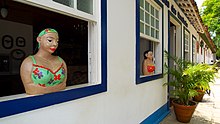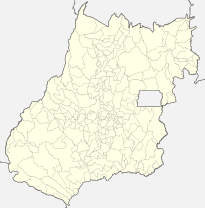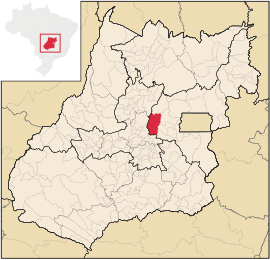Pirenópolis
| Pirenópolis | ||
|---|---|---|
|
Coordinates: 15 ° 51 ′ S , 48 ° 58 ′ W Location of the town of Pirenópolis in Goiás
|
||
| Basic data | ||
| Country | Brazil | |
| State | Goiás | |
| Residents | 23,065 ( IBGE 2010) | |
| City insignia | ||
| Detailed data | ||
| surface | 2,181.8 km 2 | |
| Population density | 10.6 inhabitants / km 2 | |
| height | 780 m | |
| City structure | 6 administrative regions ( Regiões Administrativas ) | |
| prefix | +5562 | |
| Time zone | UTC −3 ( summer : −2) | |
| City Presidency | Nivaldo Antônio de Melo, PP (2009–2012) | |
| Website | ||
| Location of the municipality of Pirenópolis in Goiás | ||
Pirenópolis , officially Portuguese Município de Pirenópolis , is a small Brazilian town in the state of Goiás . With its listed historical center, it is a frequent destination for tourists .
history
The prehistory: The Indian tribes
All of Brazil and of course Goiás is strongly influenced by the culture of the various Indian tribes. In the state of Goiás it was mainly the Goyaz tribe who gave the state its current name. In addition to the Goyá, the Caiapós, Acroás, Bororos, Karajá , Xavantes, Xerentes and Xacriabás lived in the area . Most of them were semi-nomadic; that is, they stayed only a short time in a place where they put up tents of wood and banana leaves and grew cassava before moving on.
After the conquest by the Portuguese, there were many fights between whites and Indian tribes with great bloodbaths and conflicts in which thousands of people died on both sides, but especially among the Indians. The whites prevailed and from then on massively suppressed the Indian tribes.
The first phase: the gold cycle (1727 to 1800)
Minas de Nossa Senhora do Rosário de Meia Ponte , the first name of the town of Pirenópolis founded in 1727, reminds on the one hand of its origins, namely the mining of the gold deposits discovered by Amaro Leite. On the other hand, the name is reminiscent of the first church, Nossa Senhora do Rosário , built between 1728 and 1732 . At times it was the largest church in the Middle East of Brazil. Most of the miners came from northern Portugal and Galicia . The mining settlement received the status of an Arraial ( patch ) in 1736 , then that of a Freguesia and finally that of a Sede de Julgado (judicial district).
The city and its population continued to develop, gold mining flourished and around 1750 four new churches were built: Igreja Nossa Senhora do Rosário dos Pretos , Igreja do Nosso Senhor do Bonfim , Igreja Nossa Senhora do Carmo and Igreja de Nossa Senhora da Boa Morte da Lapa . Some of them still exist today. The building that housed the town hall and prison ( A Casa da Câmara e Cadeia ) was built in 1733, but was completely demolished in 1919.
In 1800 the gold veins were exhausted and agriculture replaced mining as the main livelihood.
The second phase: agriculture and trade (1800 to 1851)
From 1800 the trade in mules , sugar cane and cotton was intensified, with the textile industry from Great Britain particularly interested in the region's cotton. The Babilônia farm ( Fazenda Babilônia ) was also established at this time . It is now a well-known tourist attraction in Pirenópolis.
In 1819, the first celebration of the Divine and Eternal Father ( Festa do Divino Espírito Santo ) took place. In 1826 the Cavalhadas de Pirenópolis jousting games began . Here the place was called Vila de Meya Ponte , in today's spelling Vila de Meia Ponte .
In 1830 the Commander Joaquim Alves de Oliveira (1770-1851) published the Matutina Meiapontense , the first newspaper in the Middle East of Brazil. It was also the first official press organ for the Brazilian provinces of Goiás and Mato Grosso. The newspaper existed from 1830 to 1834 and was of great importance to the area.
The economic power of the region declined sharply from the middle of the 19th century, in return, trade in Santana das Antas (today Anápolis ) grew significantly.
From 1853 the place changed its status and was now called Cidade de Meia Ponte .
Bernard Amblard D'Arena started another attempt at gold mining in 1880 and built a mine in the Serra dos Pirineus (Abade) low mountain range , which, however, met with resistance from the population. After seven years, the mine was destroyed by two dozen men from the city of Meia Ponte.

The Third Phase: Isolation and Art (1890-1946)

Because Anápolis was now a trading center, the Cidade de Meia Ponte was economically isolated around 1890. In order to make the city more attractive again, the name of the city was changed to Pirenópolis that year. The idea was that Pirenópolis should be a place for cultural festivals, spectacles and activities. A theater was built in 1899 and contributed significantly to the fact that parts of the city had electricity from 1924. It was later replaced in 1936 by the Cine Pireneus , an Art Deco building.
In 1930 the construction of Goiânia (capital of the state of Goiás) began. The construction activities were a boon to the economy of Pirenópolis because the stones ( quartzite ) came from Pirenópolis. So modernization progressed and in 1937 a power station was built that could supply the entire city with electricity.
In 1946 a new bridge (The Bridge over the River of Souls) was built because the old wooden bridge from 1941 was broken.
The fourth phase: quarrying and tourism (1960 to today)
The trade in stones from Pirenópolis flourished in 1960, especially with the establishment of Brasília . During these years stone asphalt was increasingly used, an asphalt made from pieces of stone. With the help of asphalt, the first transport links to other cities such as Goiânia (GO-431 motorway, now BR-153 ) were established in 1980 , which in turn attracted strangers, at that time mainly hippies , who formed alternative communities and sold handicrafts.
Since then, the city has been one of the most famous tourist cities in midwest Brazil. Old buildings were renovated, many hotels and guest houses were built and natural attractions (such as waterfalls) were marketed for tourism. The Parque Estadual da Serra dos Pireneus nature reserve was established in 1987 in the Serra do Pireneus ( Pyrenees Mountains ) . Its highest point, Pico dos Pireneus , 20 km away , is a popular destination because of its beautiful view. During the first full moon in July, the Moon Festival takes place on this summit, during which the inhabitants perform baptisms and keep promises they have made to their saints.
Pirenópolis is also known for its more than 70 silversmiths' studios, making it Brazil's largest center for the sale of silver handicrafts.
geography
Pirenópolis is located in the Entorno de Brasília microregion between the following cities: Vila Propício in the north, Cocalzinho de Goiás , Corumbá de Goiás and Abadiânia in the east, Anápolis in the south and São Francisco de Goiás in the west. The city is about 150 km from Brasília and 130 km from Goiânia.
climate
The climate is humid and subtropical. There are two main seasons: the season from April to September is dry, from October to March it rains a lot.
economy
The city's economy consists mainly of agriculture, tourism, services and small industries (food, textiles, etc.).
- Industries: 33 (2005)
- Shops: 141 (2005)
- Banks: Banco do Brasil , Bradesco e Banco Itaú (2005)
- Cars: 1,980 (2004)
- Cattle: 132,000 animals (2004)
- Poultry: 87,000 (2004)
- Pigs: 67,000 (2004)
- the most common crops: rice, bananas, coffee, oranges, lime, soybeans, tomatoes, pineapple , cassava , corn, etc. a.
education
There are 34 schools in the city with around 6000 students and 228 teachers. The literacy rate in 2000 was 84.4% (Brazil overall: 86.4%).
health
There are 3 hospitals and 12 outpatient clinics in which a total of 55 doctors, 8 nurses and 5 dentists (2002) work. The child mortality rate in Pirenópolis in 2000 was 27.52% (Brazil as a whole: 33%).
See also
Web links
- Official website of the city of Pirenópolis (in Portuguese)
- Pirenópolis page 1 (in Portuguese)
- Pirenópolis page 2 (in Portuguese)




